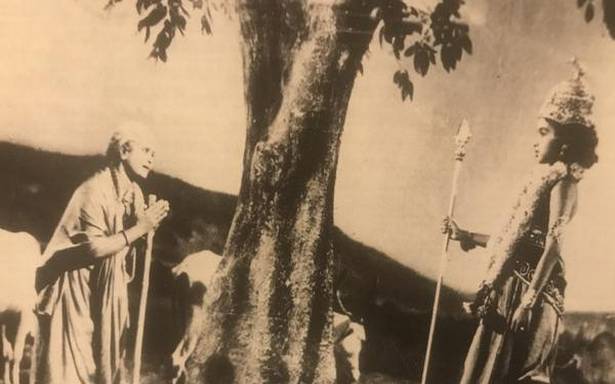Actor P.N. Kumar became famous for the ‘sutta pazham’ scene in the film Avvaiyar
Remember the ‘Sutta Pazham’ scene from Gemini’s 1953 film Avvaiyar? To many it remains the iconic moment in the movie. While it is true that K.B. Sundarambal largely carried the film, its success also had much to do with S.S. Vasan keeping a finger on the public pulse when it came to production values and pre-release publicity. The ‘Sutta Pazham’ scene, which lasts all of ten minutes, however, belonged entirely to P.N. Kumar, who played the role of Balamurugan in it. He, in fact, greatly influenced the way the youthful South Indian deity would be depicted thereafter in films, calendar art and statuary.
Born in August 1940 to P.S. Narayanan and Lakshmi at No 3, East Chitrakulam Street, Mylapore, Kumar was influenced significantly by his maternal grandfather, the famed Tamil science writer, P.N. Appuswami. He studied at Children’s Garden School and later at P.S. High School. In 1950, he enrolled at Besant Theosophical School, Adyar, when his grandfather moved to the then newly established Gandhi Nagar colony.
Training in dance
Kumar was inspired to pursue Bharatanatyam after seeing a performance by Rukmini Devi Arundale at Rasika Ranjani Sabha in Mylapore in the 1940s. “He used to dance all the time, with the correct steps and araimandi posture, and had a perfect sense of timing,” says his sister Dr. P.N. Aruna. Noticing this, Appuswami arranged for his formal training in dance under Picchai, a niece of the redoubtable Mylapore Gowri Ammal, the last hereditary devadasi of the Kapaliswarar Temple, who taught Rukmini Devi, Balasaraswathi and Vyjayanthimala among others. Appuswami’s house also echoed with music, with T.L. Venkatarama Iyer teaching Dikshitar kritis. Soon Kumar could sing well and also play several instruments.
His acting skills were noticed by scholars such as Dr. V. Raghavan, who regularly featured him in the productions of the Samskrta Ranga, which staged classical plays in Sanskrit. His performance as Malavika in Kalidasa’s Malavika Agnimitram, in particular, came in for great appreciation. V.C. Gopalratnam got him to act in the plays of the Suguna Vilasa Sabha as well. Lakshmana Aiyar, a talent scout for All India Radio, obtained permission from Kumar’s grandfather to have him act in a radio play and when it was broadcast, S.S. Vasan heard it and was impressed.
Gemini’s Avvaiyar was many years in the making. At the time of the radio play, the family was still in Mylapore. Vasan came calling and convinced Appuswami to allow Kumar to act as Murugan in the film. The responsibility of ferrying him every day to the shoot and bringing him back was entrusted to R. Ganesh, who was then a Gemini staffer and had a role as Deivigan, a prince, in the same film. ‘Gemini’ Ganesh, as he would later come to be known, fulfilled his responsibility faithfully, and became a close family friend.
Kalakshetra productions
After Avvaiyar hit the screens in 1953, Kumar received offers to act from studio houses such as AVM and Vijaya Vauhini, but his grandmother decided that one film was enough. The boy had to get serious about education. While at Besant School, he studied dance at Kalakshetra under teachers such as Rukmini Devi, Sarada Hoffman and Jayalakshmi. He graduated to performing roles in Kalakshetra’s productions, playing Lord Rama. Because of a resemblance between the two, the role of the child Rama was then entrusted to V.P. Dhananjayan, who later became a well-known dancer and guru. The performance also featured Rama Ravi and Shanta (Dhananjayan), as the young Lava and Kusa.
On completing school, Kumar enrolled at Vivekananda College, where he was a regular in plays and competitions, routinely winning prizes. The scholar Anna (Subramaniam), who was associated with Ramakrishna Mission, got him to act in plays and participate in oratorical contests. His ability to read three languages and his eidetic memory helped greatly in these assignments. It was no wonder therefore that on graduating and taking up a job in the private sector, Kumar became a part of Cho Ramaswami’s Viveka Fine Arts and acted in several plays. “He was a quiet person who excelled in female roles,” says ‘Burma’ Shankar, a regular in the same troupe. “The audience welcomed him and before the arrival of Sukumari and a couple of other actresses, he was our mainstay for women’s roles.”
In his later years, Kumar immersed himself in books and the arts. He passed away on April 9. It was a long life, mostly in the shadows in the latter part, but his talent in dance and acting deserve commemoration. And he lives on as Balamurugan.
The Chennai-based historian
writes on music and culture.
Source: Read Full Article

